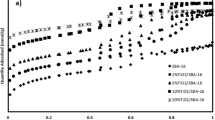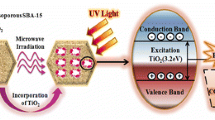Abstract
The preparation of mesoporous silica supported zinc oxide photocatalyst (MS/ZnO) was carried out using the direct and indirect approaches (impregnation) in solvent media and grinding approach (mechanochemical) in a solvent-free media. This showed the dissemination of zinc oxide nanoparticles over mesoporous substrates that associated with the formation of a secondary phase of ZnO crystallites on the mesoporous materials. Consequently, a noticeable reduction of the total surface areas, pore volume and average pore size of mesoporous materials was affirmed due to a combination of ZnO nanoparticles, which entirely investigated via the N2 adsorption and desorption isotherms. In this respect, the efficiency of the photocatalysts was recognized using the photo-degradation reaction of Ibuprofen (IBP) as an assigned model of contaminant. Interestingly, the prepared photocatalysts using grinding approach (the mechanochemical approach, the focus of this research) sustained the best photocatalytic efficacy compared to the old-style wetness impregnation approach. This is also commensurate with a complete dispersion of ZnO on mesoporous material in a solvent-free media. Overall, the recent research has confirmed the merits and flexibility of the grinding approach in the preparation of MS/ZnO photocatalyst that incorporated with an efficient removal of solvent.

Highlights
-
Efficiency increases due to the dispersion effect of catalyst supported silica.
-
No direct relation and clear impact of pore system and the activity scatter.
-
Preparation procedure has obviously strengthened the catalytic performance.
-
Low content of active component cannot prepare homogeneous mixture of catalytic component with support.
-
30% of ZnO/MCM-41-S attains 83.6% degradation at 20% mineralization of TOC.












Similar content being viewed by others
References
Arora HS, Singh H, Dhindaw BK (2012) Composite fabrication using friction stir processing—a review. Int J Adv Manuf Technol 61(9-12):1043–1055
Adnan MAM, Julkapli NM, Hamid SBA (2016) Review on ZnO hybrid photocatalyst: impact on photocatalytic activities of water pollutant degradation. Rev Inorg Chem 36(2):77–104
Kołodziejczak-Radzimska A, Jesionowski T (2014) Zinc oxide—from synthesis to application: a review. Materials 7(4):2833–2881
Chen WX, Yu JS, Hu W, Chen ZL, Memon H, Chen GL (2016) Titanate nanowire/NiO nanoflake core/shell heterostructured nanonanocomposite catalyst for methylene blue photodegradation. RSC Adv 6(72):67827–67832
Vaishnavi TS, Haridoss P, Vijayan C (2008) Optical properties of zinc oxide nanocrystals embedded in mesoporous silica. Mater Lett 62(10-11):1649–1651
Xiong Y, Zhang LZ, Tang GQ, Zhang GL, Chen WJ (2004) ZnO nanoparticles included within all-silica MCM-41: preparation and spectroscopic studies. J Lumin 110(1-2):17–22
Zeng W, Wang Z, Qian XF, Yin J, Zhu ZK (2006) ZnO clusters in situ generated inside mesoporous silica. Mater Res Bull 41(6):1155–1159
Burova LI, Petukhov DI, Eliseev AA, Lukashin AV, Tretyakov YD (2006) Preparation and properties of ZnO nanoparticles in the mesoporous silica matrix. Superlattices Microstruct 39(1-4):257–266
Bouvy C, Marine W, Sporken R, Su BL (2006) Photoluminescence properties and quantum size effect of ZnO nanoparticles confined inside a faujasite X zeolite matrix. Chem Phys Lett 428(4-6):312–316
Chen J, Feng Z, Ying P, Li C (2004) ZnO clusters encapsulated inside micropores of zeolites studied by UV Raman and laser-induced luminescence spectroscopies. J Phys Chem B 108(34):12669–12676
Bouvy C, Marine W, Su BL (2007) ZnO/mesoporous silica nanocomposites prepared by the reverse micelle and the colloidal methods: Photoluminescent properties and quantum size effect. Chem Phys Lett 438(1-3):67–71
Fernandez L, Garro N, Morales JM, Burguete P, Latorre J, Guillem C, Beltran A, Beltran D, Amoros P(2006) Supramolecular capping-ligand effect of lamellar silica mesostructures for the one-pot synthesis of highly dispersed ZnO nanoparticles Nanotechnology 17:4456–4463
Fernandez L, Garro N, El Haskouri J, Cabero MP, Rodriguez JA, Latorre J, Guillem C, Beltran A, Beltran D, Amoros P(2008) Mesosynthesis of ZnO-SiO2 porous nanocomposites with low-defect ZnO nanometric domains Nanotechnology 19:225603–225612
Silvestre-Albero J, Sepúlveda-Escribano A, Reinoso FR (2008) Preparation and characterization of zinc containing MCM-41 spheres. Microporous mesoporous Mater 113(1-3):362–369
Martins RMS, Musat V, Mücklich A, Franco N, Fortunato E (2010) Characterization of mesoporous ZnO: SiO2 films obtained by the sol–gel method. Thin Solid Films 518(23):7002–7006
Memon H, Yasin S, Khoso NA, Memon S (2016) Study of wrinkle resistant, breathable, anti-UV nanocoated women polyester fabric. Surf Rev Lett 23(03):1650003
Jiang Q, Wu ZY, Wang YM, Cao Y, Zhou CF, Zhu JH (2006) Fabrication of photoluminescent ZnO/SBA-15 through directly dispersing zinc nitrate into the as-prepared mesoporous silica occluded with template. J Mater Chem 16(16):1536–1542
Lee KM, Lai CW, Ngai KS, Juan JC (2016) Recent developments of zinc oxide based photocatalyst in water treatment technology: a review. Water Res 88:428–448
Samadi M, Zirak M, Naseri A, Khorashadizade E, Moshfegh AZ (2016) Recent progress on doped ZnO nanostructures for visible-light photocatalysis. Thin Solid Films 605:2–19
Memon H, Kumari N, Jatoi AW, Khoso NA (2016) Study of the indoor decontamination using nanocoated woven polyester fabric. Int Nano Lett 7(1):1–7
Johar MA, Afzal RA, Alazba AA, Manzoor U (2015) Photocatalysis and bandgap engineering using ZnO nanocomposites. Adv Mater Sci Eng 2015:1–22
Ibrahim M.W. (2018). Enhancement of the Efficiency of Photocatalysts by Hierarchical Structuring with Ordered Mesoporous Silicates. PhD thesis submitted to Rostock University, Germany.
Lihitkar PB, Violet S, Shirolkar M, Singh J, Srivastava ON, Naik RH, Kulkarni SK (2012) Confinement of zinc oxide nanoparticles in ordered mesoporous silica MCM-41 Mater Chem Phys 133:850–856
Author information
Authors and Affiliations
Corresponding author
Ethics declarations
Conflict of interest
The authors declare no competing interests.
Additional information
Publisher’s note Springer Nature remains neutral with regard to jurisdictional claims in published maps and institutional affiliations.
Rights and permissions
About this article
Cite this article
Ibrahim, M.W., Al-Obaidi, M.A., Kosslick, H. et al. Photocatalytic degradation of pharmaceutical pollutants using zinc oxide supported by mesoporous silica. J Sol-Gel Sci Technol 98, 300–309 (2021). https://doi.org/10.1007/s10971-021-05507-z
Received:
Accepted:
Published:
Issue Date:
DOI: https://doi.org/10.1007/s10971-021-05507-z




